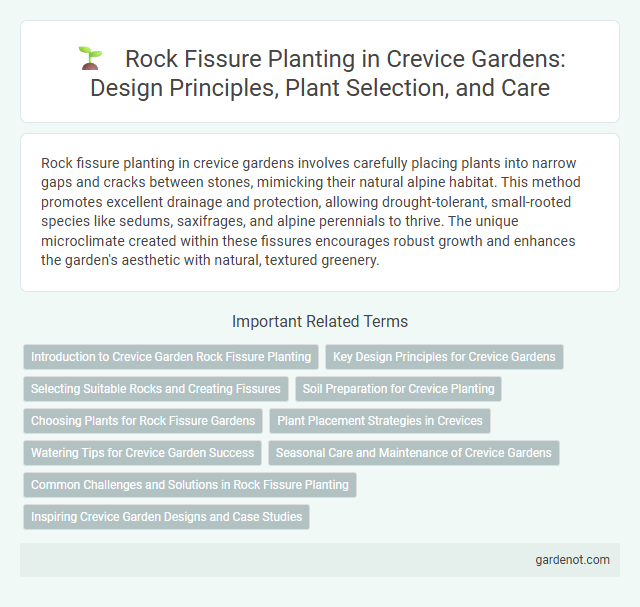Rock fissure planting in crevice gardens involves carefully placing plants into narrow gaps and cracks between stones, mimicking their natural alpine habitat. This method promotes excellent drainage and protection, allowing drought-tolerant, small-rooted species like sedums, saxifrages, and alpine perennials to thrive. The unique microclimate created within these fissures encourages robust growth and enhances the garden's aesthetic with natural, textured greenery.
Introduction to Crevice Garden Rock Fissure Planting
Crevice garden rock fissure planting mimics natural mountainous environments characterized by narrow, deep rock cracks that provide excellent drainage and shelter for specialized alpine plants. This technique supports drought-tolerant, slow-growing species such as saxifrages, sedums, and sempervivums by creating microhabitats with minimal soil, reducing competition and maintaining moisture balance. Optimal rock selection involves flat stones arranged vertically or at steep angles to form fissures, enhancing root anchorage and airflow, essential for healthy plant growth in crevice gardens.
Key Design Principles for Crevice Gardens
Rock fissure planting in crevice gardens emphasizes strategic stone placement to mimic natural fissures, providing deep, narrow gaps ideal for rooting alpine plants. Selecting weathered, angular stones ensures stability and enhances water drainage, while varying fissure depths accommodates diverse plant species and promotes microclimates. Proper orientation to maximize sun exposure and protect from harsh winds supports optimal growth and plant resilience.
Selecting Suitable Rocks and Creating Fissures
Selecting suitable rocks for crevice garden planting involves choosing durable, weather-resistant materials such as limestone, sandstone, or granite that mimic natural rocky habitats. Creating fissures requires carefully spacing and arranging rocks to form narrow, deep gaps that provide ideal microclimates for alpine and rock-loving plants. Proper fissure depth and orientation enhance drainage and root protection, promoting healthy plant growth and longevity.
Soil Preparation for Crevice Planting
Soil preparation for crevice planting requires a well-draining, gritty mix that mimics natural rock fissures, often blending sharp sand, gravel, and a small amount of organic matter to avoid water retention. The planting medium should be loosely packed to enable root growth within crevices while preventing compaction that can restrict airflow. Ensuring the soil remains slightly alkaline promotes healthy growth for alpine and crevice plants adapted to rocky habitats.
Choosing Plants for Rock Fissure Gardens
Selecting plants for rock fissure gardens requires species that thrive in narrow, well-drained crevices with limited soil. Succulents such as Sedum and Sempervivum excel due to their drought tolerance and shallow root systems. Alpine plants like Saxifraga and Phlox can also adapt well, providing vibrant color and texture while enduring harsh conditions typical of rock fissures.
Plant Placement Strategies in Crevices
Plant placement strategies in crevices prioritize selecting species with shallow root systems that thrive in minimal soil, such as saxifrages and alpine succulents. Positioning plants to maximize sunlight exposure while ensuring proper drainage within narrow fissures enhances growth and prevents root rot. Integrating varying heights and textures within rock gaps creates natural microhabitats, supporting biodiversity and mimicking native alpine ecosystems.
Watering Tips for Crevice Garden Success
Rock fissure planting in crevice gardens requires precise watering techniques to ensure plant health and growth. Water deeply but infrequently, allowing the substrate to dry out between sessions to mimic natural conditions and prevent root rot. Employ drip irrigation or water at the base of plants to target moisture directly to root zones, optimizing water efficiency and reducing evaporation.
Seasonal Care and Maintenance of Crevice Gardens
Seasonal care of crevice gardens involves regular inspection of rock fissures to remove debris and prevent soil compaction, ensuring optimal drainage for specialized alpine and drought-tolerant plants. During spring and autumn, nutrient monitoring and selective pruning encourage healthy growth and flowering while minimizing stress on delicate root systems embedded in narrow crevices. Winter protection strategies include mulching around sensitive species and clearing snow accumulation to reduce moisture-related rot and freeze-thaw damage unique to rock fissure environments.
Common Challenges and Solutions in Rock Fissure Planting
Rock fissure planting often faces challenges such as limited soil depth, moisture retention issues, and root space constraints, which can affect plant establishment and growth. Selecting drought-tolerant, shallow-rooted species and improving soil quality with organic matter are effective solutions to enhance plant survival. Regular monitoring of moisture levels and strategic placement of plants in naturally sheltered fissures can further optimize growth in crevice garden environments.
Inspiring Crevice Garden Designs and Case Studies
Rock fissure planting in crevice gardens emphasizes using narrow, naturally occurring gaps between stones to cultivate drought-tolerant alpine plants that thrive in minimal soil. Inspiring crevice garden designs showcase examples such as the renowned Rocky Mountain Garden, where stone placement mimics natural mountain fissures, promoting biodiversity and microclimate creation. Case studies highlight the successful integration of sedums, saxifrages, and dwarf conifers, demonstrating how precise stone alignment enhances root development and water retention in rock fissures.
Rock fissure planting Infographic

 gardenot.com
gardenot.com